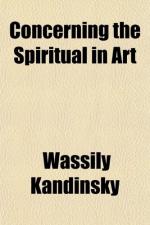Whither is this lifetime tending? What is the message of the competent artist? “To send light into the darkness of men’s hearts—such is the duty of the artist,” said Schumann. “An artist is a man who can draw and paint everything,” said Tolstoi.
Of these two definitions of the artist’s activity we must choose the second, if we think of the exhibition just described. On one canvas is a huddle of objects painted with varying degrees of skill, virtuosity and vigour, harshly or smoothly. To harmonize the whole is the task of art. With cold eyes and indifferent mind the spectators regard the work. Connoisseurs admire the “skill” (as one admires a tightrope walker), enjoy the “quality of painting” (as one enjoys a pasty). But hungry souls go hungry away.
The vulgar herd stroll through the rooms and pronounce the pictures “nice” or “splendid.” Those who could speak have said nothing, those who could hear have heard nothing. This condition of art is called “art for art’s sake.” This neglect of inner meanings, which is the life of colours, this vain squandering of artistic power is called “art for art’s sake.”
The artist seeks for material reward for his dexterity, his power of vision and experience. His purpose becomes the satisfaction of vanity and greed. In place of the steady co-operation of artists is a scramble for good things. There are complaints of excessive competition, of over-production. Hatred, partisanship, cliques, jealousy, intrigues are the natural consequences of this aimless, materialist art.
[Footnote: The few solitary exceptions do not destroy the truth of this sad and ominous picture, and even these exceptions are chiefly believers in the doctrine of art for art’s sake. They serve, therefore, a higher ideal, but one which is ultimately a useless waste of their strength. External beauty is one element of a spiritual atmosphere. But beyond this positive fact (that what is beautiful is good) it has the weakness of a talent not used to the full. (The word talent is employed in the biblical sense.)]
The onlooker turns away from the artist who has higher ideals and who cannot see his life purpose in an art without aims.
Sympathy is the education of the spectator from the point of view of the artist. It has been said above that art is the child of its age. Such an art can only create an artistic feeling which is already clearly felt. This art, which has no power for the future, which is only a child of the age and cannot become a mother of the future, is a barren art. She is transitory and to all intent dies the moment the atmosphere alters which nourished her.




